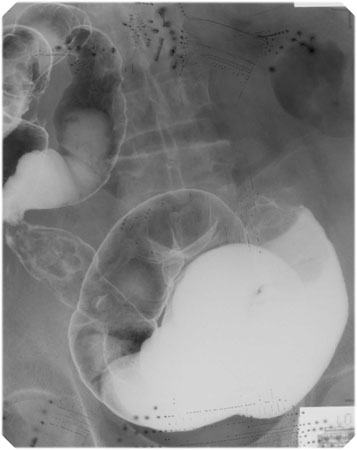- A retrograde ileostomy contrast study is done on patients who
are scheduled for an ileo-anal pouch procedure to
check for Crohns disease or to retrogradely assess the small bowel
for recurrence of Crohns or other bowel symptoms such as obstruction.
- It is a difficult examination because of the retrograde nature
of the instillation of contrast and the anterograde peristaltic
movement of the ileum. It is therefore advisable to give a hypotonic
agent intravenously such as Glucagon (1 mgm) or Buscopan (10 mgm).
Technique
- A 14F or 16F Foley catheter and Polibar plus barium
(105% w/v) is diluted down to about 30-50% w/v concentration or
hypaque 30% (when clinically indicated)
- After administering the hypotonic agent, the catheter is inserted
into the ileostomy opening, inflating the balloon to prevent reflux
of the barium.
- About at least ½ the length of the small bowel (minimum
of 40 cm) should be filled with barium depending on the history
of the patient.
- For patients scheduled for an ileo-anal pouch procedure about
1/3 (2-4 feet) of the small bowel opacified is sufficient. The
stomal segment of the small bowel (between the catheter and the
ileostomy opening) should be imaged at the end of the study.
- The stomal position is best examined by placing the patient
in an oblique or lateral position to elongate the stoma.
- At least one 14 x 14 or 14 x 17 radiograph should be taken
to get an overview of the small bowel along with other spot views
of the different segments of small bowel.
- If technically possible, you can instill air retrogradely to
perform a double contrast exam.
|
 |
|
|